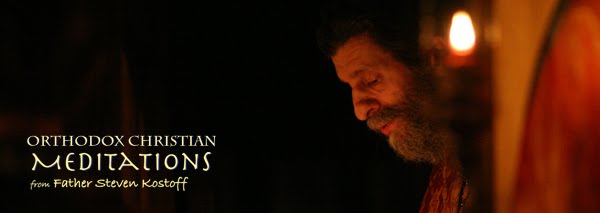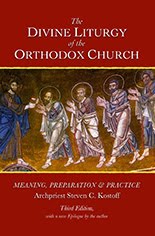 Dear Parish Faithful & Friends in Christ,
Dear Parish Faithful & Friends in Christ,We enjoyed a truly wonderful celebration of the Feast of the Dormition of the Theotokos yesterday evening. Attendance was very strong, there was a full choir, and the Vesperal Liturgy both lively and prayerful. As always, it was good to see some of our parish children and young adults present and worshiping. This "summer pascha" has steadily become an integral event of our parish life. And this is "meet and right." American Christianity has been shaped by the Protestant ethos, and that basically means that there is no real place for the veneration of the Mother of God. This was primarily based upon a reaction against the perceived excesses of the medieval West's Marian piety by the early Protestant reformers. In a short time, this reaction became a thorough rejection - at times quite vehement - in many Protestant circles. So the Virgin Mary pretty much disappeared from Protestant worship and piety. Perhaps the classic example within Church history of "throwing out the baby with the bath water." Orthodox Christians cannot succumb to any such truncated form of the Church's living Tradition.(However, there have been clear signs recently of a "recovery" of the role of the Virgin Mary in some Evangelical circles). One of my beloved professors from seminary always used to say that a sign of a spiritually strong parish is that parish's devotion to the Mother of God. For she is the personal image of the Church - warm, embracing, nurturing, protecting.
Since the Dormition has no biblical source, this feast slowly developed over the course of the first five centuries of the Church's history on the basis of a wide variety of sources - primarily narratives, rhetorical homilies and theological poetry/hymnography (Much of this material now exists in English translation). There is no one authoritative text or document. However, though details may differ, a tradition emerged that tells of how the apostles were miraculously brought back to Jerusalem in order to surround the bedside of the Virgin Mary as she lay dying. Upon commending her holy soul to her Son and Savior, she peacefully "fell asleep" in death (the meaning of the word dormition) in the presence of the apostles who stood weeping and grief-stricken by her bedside. With great solemnity they buried her pure body which had itself been the "tabernacle" of the King. The traditional place of her burial is a tomb close to Gethsemane. When the tomb was opened on the third day so that the Apostle Thomas, who arrived late, could venerate the body of the Theotokos, it was found to be empty. The "Mother of Life" was thus "translated to life!"
Archbishop Kallistos Ware summarizes the Church's understanding of this tradition in the following manner:
Without insisting of the literal truth of every element in this account, Orthodox tradition is clear and unwavering in regard to the central point: the Holy Virgin underwent, as did her Son, a physical death, but her body - like His - was afterwards raised from the dead and she was taken up into heaven, in her body as well as in her soul. She has passed beyond death and judgement, and lives wholly in the Age to Come. The Resurrection of the Body, which all Christians await, has in her case been anticipated and is already an accomplished fact. That does not mean, however, that she is dissociated from the rest of humanity and placed in a wholly different category: for we all hope to share one day in that same glory of the Resurrection of the Body which she enjoys even now. (The Festal Menaion, p. 64)
Fr. Thomas Hopko further elaborates on the meaning of this beautiful Feast and how it "relates" to every generation of Christians:
Thus, the feast of the Dormition of the Theotokos is the celebration of the fact that all men are "highly exalted" in the blessedness of the victorious Christ, and that this high exaltation has already been accomplished in Mary the Theotokos. The feast of the Dormition is the sign, the guarantee, and the celebration that Mary's fate is the destiny of all those of "low estate" whose souls magnify the Lord, whose spirits rejoice in God the Savior, whose lives are totally dedicated to hearing and keeping the Word of God which is given to men in Mary's child, the Savior and Redeemer of the world.
The Leavetaking of the Feast is on August 23. That means that we continue to sing and chant the troparion and kontakion of the Feast in our liturgical services until then, in addition to the other hymnography of the Feast. I would strongly urge everyone to incorporate these hymns into your daily rule of prayer, including their use when you bless your meals as a family, replacing the Lord's Prayer up until the Leavetaking. If you can't sing these hymns, you can certainly recite them! This is how we bring a remembrance of the Feasts into our homes. The troparia and kontakia of the major Feasts are included in many Orthodox Prayer Books, but if you do not have the texts available at home, I am including them here:
Troparion of the Dormition
In giving birth, you preserved your virginity!
In falling asleep you did not
forsake the world, O Theotokos!
You were translated to life, O Mother of Life,
and by your prayers you deliver our souls from death!
Kontakion of the Dormition
Neither the tomb, nor death, could hod the Theotokos,
who is constant in prayer and our firm hope in her intercessions.
For being the Mother of Life, she was translated to life
by the One who dwelt in her virginal womb!
The decorated tomb of the Theotokos, containing an icon of her sacred body in blessed repose, will be back in its usual place and open to our veneration whenever we enter the church. The great Feasts extend in time, giving us the opportunity of integrating them into our lives in a meaningful way.
Fr. Steven












